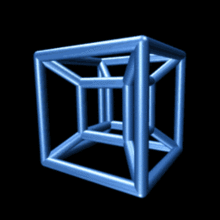Negative-dimensional space
In topology, a discipline with in mathematics, a negative-dimensional space is an extension of the usual notion of space allowing for negative dimensions.[1]
Definition
Suppose that Mt0 is a compact space of Hausdorff dimension t0, which is an element of a scale of compact spaces embedded in each other and parametrized by t (0 < t < ∞). Such scales are considered equivalent with respect to Mt0 if the compact spaces constituting them coincide for t ≥ t0. It is said that the compact space Mt0 is the hole in this equivalent set of scales, and −t0 is the negative dimension of the corresponding equivalence class.[2]
History
By the 1940s, the science of topology had developed and studied a thorough basic theory of topological spaces of positive dimension. Motivated by computations, and to some extent aesthetics, topologists searched for mathematical frameworks that extended our notion of space to allow for negative dimensions. Such dimensions, as well as the fourth and higher dimensions, are hard to imagine since we are not able to directly observe them. It wasn’t until the 1960s that a special topological framework was constructed—the category of spectra. A spectrum is a generalization of space that allows for negative dimensions. The concept of negative-dimensional spaces is applied, for example, to analyze linguistic statistics.[3]
See also
References
- ↑ Wolcott, Luke; McTernan, Elizabeth (2012). "Imagining Negative-Dimensional Space" (PDF). In Bosch, Robert; McKenna, Douglas; Sarhangi, Reza. Proceedings of Bridges 2012: Mathematics, Music, Art, Architecture, Culture. Phoenix, Arizona, USA: Tessellations Publishing. pp. 637–642. ISBN 978-1-938664-00-7. ISSN 1099-6702. Retrieved 25 June 2015.
- ↑ Maslov, V. P. (2007). "General notion of a topological space of negative dimension and quantization of its density". Mathematical Notes. 81: 140. doi:10.1134/S0001434607010166.
- ↑ Maslov, V. P. (2006). "Negative dimension in general and asymptotic topology". arXiv:math/0612543
 .
.
External links
- Отрицательная асимптотическая топологическая размерность, новый конденсат и их связь с квантованным законом Ципфа. For a translation into English, see Maslov, V.P. (November 2006). "Negative asymptotic topological dimension, a new condensate, and their relation to the quantized Zipf law". Mathematical Notes. 80 (5–6): 806–813. doi:10.1007/s11006-006-0203-7. Retrieved 30 June 2015.
